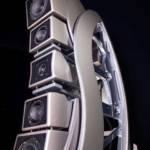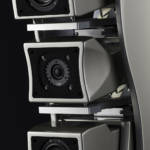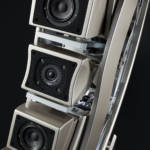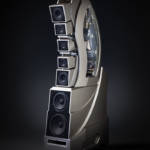There are among us rare individuals who are compelled to follow their passions, prepared to work hard and sacrifice for what they believe and, above all, not allow anyone to limit their dreams. Dave Wilson is such a person. Enzo Ferrari famously observed, “If you can dream it, you can do it.” Enzo raced; Dave’s passion is for music and its reproduction.
Dave is animated by an unquenchable curiosity, which is, in turn, fueled by a boundless yearning for discovery. He has spent the better part of his life engaged in the difficult and demanding work of turning his impossibly ambitious dreams into remarkable physical creations. Since he can remember, Dave has been obsessed with the sound of live music. Early on he asked this simple question: Why do certain transducers sound more like the live event, while others sound like loudspeakers? What is it about certain combinations of drivers, cabinet materials, and even the geometric arrangement of those drivers that produces an intellectually and emotionally convincing verisimilitude of live music?
He also examined the best methods to answer these questions. Many audio designers of that time were intellectually bound to a priori tenets—such as ultra-flat frequency response or phase-correct, first-order crossovers—as the beginning and end of their design methodology. Rather than exploring a potential design strategy via honest and rigorous empirical testing in an effort to discover the virtue of a favored hypothesis, these designers saw their ideas as absolute articles of faith. Other speaker designers shrouded themselves in an aura of tweaky mysticism. They imbued their products and the underlying “technology” with an intentionally misleading inscrutability, when, in reality, their loudspeakers were nearly entirely bereft of actual science.
Unfortunately, many of these design trends continue today.
Unique in the audio world, Dave is a natural scientist. As such, he is dedicated to the rigorous application of the scientific method. Dave understands that the veracity of any given theory is inextricably tied to the result it produces. Put more simply, if it sounds real, the science is real.
In the late seventies, Dave began to understand the importance of the time domain—specifically as it related to the transient propagation of individual drivers. He discovered that even tiny errors in the alignment of the drivers in relationship to the listener caused obvious sound-quality degradation. When the drivers were aligned accurately to the listening position, the loudspeaker sounded far more lifelike. These discoveries led to a patent for adjustable-propagation-delay loudspeaker arrays, as well as the method to measure time-domain distortion. Wilson Audio’s first commercial product, the WAMM (Wilson Audio Modular Monitor), was the physical manifestation of Dave’s theories. The WAMM was a multi-module loudspeaker, each module physically adjustable in relationship to one another in the time domain.
To call the WAMM a breakthrough is an exercise in understatement.
Peter Moncrieff, editor of International Audio Review, proclaimed the WAMM was “audio in its noblest form.” Larry Archibald, then the publisher of Stereophile, said the WAMM was “…the most enjoyable speaker system I’ve listened to, and significantly valuable as a diagnostic tool.”
Since those auspicious nascent days, Dave and Sheryl Lee’s sheer determination and passionate commitment became an essential element in their effort to not just to survive the challenges and obstacles endemic to small startups, but to nurture and develop Wilson Audio into one of the most respected brands and companies in the audio industry. Wilson grew beyond their garage in Northern California into larger and larger commercial spaces, and finally settled in a state-of-the-art facility in Provo, Utah. Dave led the company based on a philosophy of authentic values—values that are as central to Wilson’s success as are Dave’s myriad breakthrough loudspeaker designs. He also assembled and mentored one of the deepest and most talented engineering teams in the history of loudspeaker design. With the team came expertise, technology, and design tools that were simply unimaginable during the time Dave designed the original WAMM.
About five years ago, Dave realized the investment he and Sheryl had made over several decades—cultivating the best design team and developing a modern manufacturing infrastructure—presented a unique opportunity. What if he were to revisit the WAMM concept with these new assets at his side? He came to understand it was time to push his talented and technologically savvy design team to new extremes. He began work on a new WAMM, a design that would not merely be worthy of its namesake, but would redefine (again) the idea of what is possible in music reproduction.
The result of that five-year project is the WAMM Master Chronosonic™.
The Master Chronosonic is Dave Wilson’s ultimate artistic expression, pushing the boundaries of Wilson Audio’s state-of-the-art manufacturing capabilities while maintaining the hand-crafted guild culture for which Wilson Audio is famous.
The Master Chronosonic™ Adjustable Array
The hallmark of the Master Chronosonic’s technical achievement, and the principal factor central to its unique ability to sound utterly lifelike, is the Master Chronosonic Adjustable Array. The Master Chronosonic is capable of time-domain accuracy heretofore possible only in the theoretical realm. The Master Chronosonic Micrometer System gives the new WAMM an unprecedented level of adjustability. Module adjustability is refined down to a previously inconceivable five microseconds (five-millionths of a second) per adjustment increment. Special attention was paid to maintaining extreme rigidity in the movable areas. The flat-bed hardware supporting the tweeter and upper midrange modules utilizes a unique combination of Wilson’s latest composite, W-Material, and aluminum. The front-firing modules never interface with aluminum, but instead are attached to a W-Material substructure below, which provides extraordinary vibration termination.
Drivers:
Tweeter
Dave Wilson and his team of engineers recently concluded another round of research and development into tweeter technology. The research included tweeter domes constructed of diamond and beryllium. After exhaustive testing and listening, Dave Wilson and his team concluded that the silk-dome Convergent Synergy Tweeter remains the most musically authentic, intrinsically satisfying tweeter yet tested. Wilson’s unique holistic approach to design was at play here—employing a combination of carefully conducted measurements and empirical listening. The Wilson-designed Convergent Synergy was further and specifically developed for the Master Chronosonic, and is designated as the Mark V version.
Two-way Midrange
Wilson’s MTM configurations have always been far more sophisticated and complex than competing designs. Rather than mounting the three drivers that make up the MTM in a flat baffle, each driver is mounted in its own module. The modules are, in turn, adjustable relative to each other, which facilitates alignment in the critical time domain within the loudspeaker array. Another advantage to modularity is the ability to optimize the construction of each module, with the specific combinations of composites best suited to the needs of each driver.
Led by Dave, Wilson Audio’s engineering team have re-imagined the MTM geometry for the Master Chronosonic. The midrange is divided between two drivers, a seven-inch and five-inch for both the bottom and top portions of the MTM array. Each of the two covers a portion of the midband area. The seven-inch is a bespoke modified version of the celebrated Wilson mid, first introduced in the Alexandria Series 2. The five-inch is an eminently musical midrange driver and covers the important upper-midrange area up to the point where it crosses over to the Convergent Synergy Tweeter. The frequencies covered by the two drivers are therefore both expanded upward and downward in frequency when compared to previous Wilson designs—the two together covering a broader portion of the midrange. Furthermore, each driver is optimized for the portion of the midband best suited to its unique strength. The engineers at Wilson have blended the two drivers masterfully, ensuring that the two perform seamlessly and coherently together.
Woofer
Unlike the original WAMM, which required a subwoofer to cover the bottom octave, the Master Chronosonic is a true full-range design. In order to achieve Dave’s design goals, it was decided that an all-new approach in the area of bass drivers was needed. The design imperative was to maximize transient integrity, speed, and bottom-octave extension. The all-new ten-inch and twelve-inch woofers were designed from the ground up to complement each other, specifically addressing the challenges presented by concentric-diameter cones in a single enclosure. These new woofers incorporate all of Wilson’s latest thinking on accurate and musical low-frequency music reproduction. The Master Chronosonic’s heroic bass enclosure, with its unmatched ability to control and eliminate unwanted resonances, is the ideal platform in which to mount the Master Chronosonic bass drivers.
Rear-firing Module
The rear-firing module is optimized for ceiling heights normally found in domestic environments and increases spatial retrieval and overall soundstage resolution. The tweeter was specifically designed for the application. It utilizes the rear wave chamber from the Mark 5 version of the Convergent Synergy Tweeter. The 5” midrange was also specifically developed for this application.
Enclosure Architecture and Materials:
In a world where most loudspeaker manufacturers are content with building enclosures from medium-density fiberboard—a material originally used in the construction of tract-home sub-floors—Wilson has spent the last several decades developing cutting-edge composites. On another front, it’s not unfair to suggest that Wilson’s obsessive attention to the deleterious effects of inadequate enclosure materials has started a fad—it’s become de rigueur for high-end loudspeaker manufacturers to parade their latest material of choice. But it’s also fair to say that the clear majority of these market-driven efforts are intrinsically one-dimensional. Put simply, loudspeaker designers typically focus on a single material, whether it is aircraft-grade aluminum or the latest trend in carbon fiber. Materials research has been a key focus of Wilson’s ongoing efforts to push the envelope of loudspeaker performance. Wilson’s materials-research facility is equipped with cutting-edge tools, including the latest technology in the area of laser doppler vibrometry. This aerospace testing tool allows Wilson’s engineers to observe and correct cabinet vibrations at the level of nanometers (one-billionth of an inch).
X-Material
The third generation of X-Material has its roots in its namesake: the X-1 Grand SLAMM. But it is also a beneficiary of Wilson’s ongoing materials research. “X” is a material that, at first, seems paradoxical but is, in reality, the result of decades of research into those areas of loudspeaker-enclosure science that truly contribute to musical veracity. No other material possesses its (seemingly contradictory) combination of extreme rigidity, monotonicity, modulus of elasticity, and intrinsic damping.
X-Material is strategically utilized throughout the Master Chronosonic enclosure, and is central to the unprecedented effort to reduce enclosure-born colorations to historical lows.
While X-Material represents the current state of the art in many salient performance areas, Wilson learned long ago that no composite is ideal for all applications. This understanding—seemingly unique to Wilson Audio—has led to the development of other materials more optimized to cover the areas for which X-Material is less than absolutely ideal.
S-Material
The research surrounding the Sasha W/P led to the development of S-Material, which is used in all the midrange baffles. S is similar to X in its damping characteristics, but is ideally suited to the musically critical midrange drivers.
W-Material
Wilson Audio’s latest breakthrough in composite technology—W-material—was previewed in the Alexx. Named for the WAMM Master Chronosonic for which it was developed, W-Material’s combination of damping characteristics (it turns vibrations into heat with unprecedented rapidity), modulus of elasticity, and extreme rigidity breaks new ground. “W” works extremely well at silencing unwanted energy. The material is positioned in the sub-plate of the Master Chronosonic adjustment truck bed—the module transfer point in the array superstructure—to optimize the upper modules’ coupling to the cabinet.
Aerospace-Grade Aluminum
The infrastructural gantry supporting time-domain adjustability is constructed from aerospace-grade aluminum. Aluminum’s singular virtue is its extreme modulus of elasticity. This quality makes it the ideal material to form the support structure for the modules, ensuring that the overall rigidity of the module launch points is maintained. Because even the best aluminum is not ideally suited for driver interface or module damping, the Master Chronosonic employs Wilson’s composites, X-, W-, and S-Materials in these locations.
The aluminum is finished in a beautiful Guilloché machined pattern, calling to mind the finest Swiss watches.
XLF Port Technology
First pioneered in the Wilson Alexandria XLF, the Master Chronosonic’s port is movable to either the front or rear of the bass enclosure. While this does not change the anechoic behavior of the deep bass, the tool enables the Master Chronosonic to interface more seamlessly with a larger number of rooms.
It’s relatively easy to achieve flat frequency response in an anechoic chamber. But, in the real world, the sound of loudspeakers is highly dependent on the room they are in. Room-induced bass nonlinearity is a problem that has generated many solutions. One of the most common is active equalization, often processed in the digital domain. The downside is that insertion of an electronic equalizer into the audio signal produces deleterious audible effects in the rest of the frequency spectrum.
Wilson has always taken a purist approach to bass management, focusing on designs that inherently sound right in a wide range of rooms. Critical room placement by Wilson-trained installers has proved to be the most successful and efficient way to overcome most room-induced colorations.
Dave Wilson conceived the Cross-Load Firing port as an effective remedy for room-induced bass artifacts. An elegantly simple idea, the (patent-pending) Cross-Load system allows the user to choose either a front- or rear-firing port configuration.
On the front of the Master Chronosonic, just below the woofers, is a distinctive plate. In rooms where the rear-firing option will tend to produce heavy bass, it is simply a matter of removing the front plate and port plug, switching those items to the rear, and attaching the low-turbulence trim to the front, moving the port exit to the front of the Master Chronosonic.
Other Architectural Details
The woofer baffle is angled toward the upper array at 6.5 degrees, which improves the time alignment of the woofers in relationship to the listener’s position. The open architecture of the Master Chronosonic’s upper gantry minimizes stored sonic energy behind upper modules. The resistor-access panel features a new approach with improved access. The resistor heatsinks are custom built for the Master Chronosonic, each chosen for its combination of sonic and thermal performance.
A new system of cable dressing, which features rotary cable tensioners, makes its debut in the Master Chronosonic. While the new system is beautiful, the design was engineered to reduce the deleterious effects of magnetostriction. Similarly, custom-made enclosure-breach-point hardware, which terminates each corresponding cable into the rear of its respective enclosure, minimizes wire connection points throughout the loudspeaker system, and minimizes degradation throughout the wired signal path.
Even the fabric grilles that optionally cover each of the module’s drivers are hand-built using ultra-low-acoustical-impedance material.
Price (U.S. MSRP)—$685,000.00 (pair)
Availability:
Production Limited 70 pairs
The WAMM Master Chronosonic is extremely labor- and time-consuming to manufacture—each pair takes approximately ten weeks to complete. As a result, the new the Master Chronosonic can only be produced for a limited time and in limited quantities. Wilson Audio will limit production to 70 pairs. Dave Wilson is committed to first offering the Master Chronosonic to those loyal customers who have supported Wilson Audio over the years. It is his way of showing his gratitude and commitment to those customers who have demonstrated a past loyalty to Wilson Audio, for those listeners who, with Dave, are dedicated to the art of music reproduction.
Magnum Opus
For the past five years, Dave Wilson has poured his heart, attention, expertise, enormous experience, and his company’s resources into the development of a new WAMM. For Dave, the Master Chronosonic is the culmination of his formidable career—a career that has spanned his lifetime, the fruit of which has been several of the most technically creative and musically compelling loudspeakers in the history of audio. This new loudspeaker is Dave’s magnum opus, a laboratory-grade loudspeaker with a single purpose: to convincingly convey the mind-ennobling and spirit-enhancing beauty of music.
Measurements:
Nominal Impedance: 3 ohms / minimum 1.77 ohms @ 310 Hz
Sensitivity: 90 dB @ 1W @ 1m @ 315Hz
Frequency Response: 20 Hz—33 kHz +/- 2 dB
Minimum Amplification Power Recommended: 100 watts/channel
Drivers:
Main Tweeter: 1 inch (2.54 cm) Convergent Synergy (Mk5), Dome Material: Doped Silk Fabric
Upper Mid-Ranges: (2) 5 inch (12.70 cm) Cone Material: Paper Pulp Composite
Lower Mid-Ranges (2) 7 inch (17.78 cm) Cone Material: Doped Paper Pulp
Woofer: 10.5 inches (26.67 cm) Cone Material: Hard Paper Pulp
Woofer: 12.5 inches (31.75 cm) Cone Material: Hard Paper Pulp
Rear Firing Tweeter: 1 inch (2.54 cm) Dome Material: Doped Silk Fabric (Mk5)
Rear Firing Mid-Range: 5 inches (12.70 cm) Cone Material: Paper Pulp Composite
Dimensions:
Height: 84 ⅜ inches (214.29 cm) w/o spikes
Width: 21 inches (53.34 cm)
Depth: 37 ⅜ inches (94.87 cm)
Enclosure Type
MainTweeter (Sealed): Material: X-Material
4” Main Mid Module (Bottom Vent): Material: X-Material with S-Material Baffle
7” Main Mid Module (Bottom Vent): Material: X-Material with S-Material Baffle
Woofer (Cross Load Firing Port (XLF)): Material: X-Material
Rear Firing Enclosure (Sealed): Material: X-Material with S-Material Baffle
Gantry: Aerospace Aluminum with W-Material Module Interface









